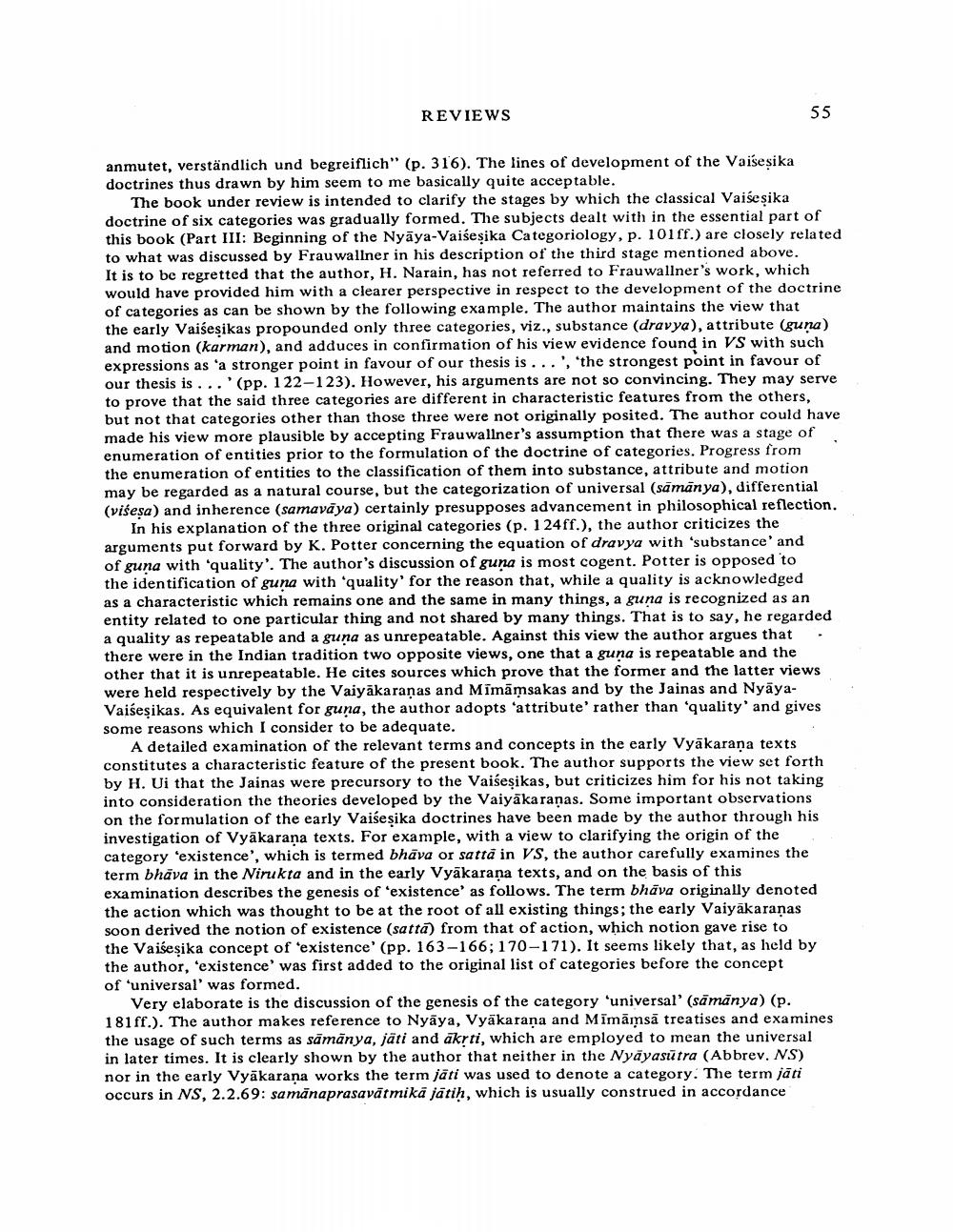________________
REVIEWS
anmutet, verständlich und begreiflich" (p. 316). The lines of development of the Vaišeşika doctrines thus drawn by him seem to me basically quite acceptable.
The book under review is intended to clarify the stages by which the classical Vaišeşika doctrine of six categories was gradually formed. The subjects dealt with in the essential part of this book (Part III: Beginning of the Nyāya-Vaiśeşika Categoriology, p. 101ff.) are closely related to what was discussed by Frau wallner in his description of the third stage mentioned above. It is to be regretted that the author, H. Narain, has not referred to Frauwallner's work, which would have provided him with a clearer perspective in respect to the development of the doctrine of categories as can be shown by the following example. The author maintains the view that the early Vaišeşikas propounded only three categories, viz., substance (dravya), attribute (guna) and motion (karman), and adduces in confirmation of his view evidence found in VS with such expressions as a stronger point in favour of our thesis is ...', 'the strongest point in favour of our thesis is ...' (pp. 122-123). However, his arguments are not so convincing. They may serve to prove that the said three categories are different in characteristic features from the others, but not that categories other than those three were not originally posited. The author could have made his view more plausible by accepting Frauwallner's assumption that there was a stage of enumeration of entities prior to the formulation of the doctrine of categories. Progress from the enumeration of entities to the classification of them into substance, attribute and motion may be regarded as a natural course, but the categorization of universal (sāmánya), differential (višesa) and inherence (samavāya) certainly presupposes advancement in philosophical reflection.
In his explanation of the three original categories (p. 1 24ff.), the author criticizes the arguments put forward by K. Potter concerning the equation of dravya with 'substance' and of guna with 'quality'. The author's discussion of guna is most cogent. Potter is opposed to the identification of guna with 'quality for the reason that, while a quality is acknowledged as a characteristic which remains one and the same in many things, a guna is recognized as an entity related to one particular thing and not shared by many things. That is to say, he regarded a quality as repeatable and a guna as unrepeatable. Against this view the author argues that . there were in the Indian tradition two opposite views, one that a guna is repeatable and the other that it is unrepeatable. He cites sources which prove that the former and the latter views were held respectively by the Vaiyakaranas and Mimāmsakas and by the Jainas and NyāyaVaišeşikas. As equivalent for guna, the author adopts 'attribute' rather than 'quality and gives some reasons which I consider to be adequate.
A detailed examination of the relevant terms and concepts in the early Vyakarana texts constitutes a characteristic feature of the present book. The author supports the view set forth by H. Ui that the Jainas were precursory to the Vaišeşikas, but criticizes him for his not taking into consideration the theories developed by the Vaiyākaraņas. Some important observations on the formulation of the early Vaišesika doctrines have been made by the author through his investigation of Vyakaraņa texts. For example, with a view to clarifying the origin of the category 'existence', which is termed bhāva or satta in VS, the author carefully examines the term bhäva in the Ninukta and in the early Vyakarana texts, and on the basis of this examination describes the genesis of 'existence as follows. The term bhäva originally denoted the action which was thought to be at the root of all existing things; the early Vaiyakaranas soon derived the notion of existence (satta) from that of action, which notion gave rise to the Vaišeşika concept of 'existence' (pp. 163-166; 170-171). It seems likely that, as held by the author, 'existence' was first added to the original list of categories before the concept of 'universal' was formed.
Very elaborate is the discussion of the genesis of the category 'universal' (samanya) (p. 181 ff.). The author makes reference to Nyāya, Vyakarana and Mimāmsă treatises and examines the usage of such terms as sämänya, jäti and akrti, which are employed to mean the universal in later times. It is clearly shown by the author that neither in the Nyāyasūtra (Abbrev, NS) nor in the early Vyakarana works the term jāti was used to denote a category. The term jāti occurs in NS, 2.2.69: samänaprasavātmikä jätih, which is usually construed in accordance




